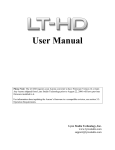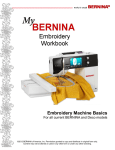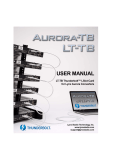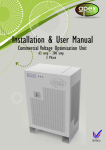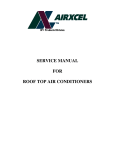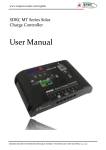Download Quartzlock A5-12 Service manual
Transcript
Model 2A Operation And Service Manual 2A Off Air Frequency Standard OPERATION & SERVICE MANUAL 2A Manual A5 21 January 2005 Page 1 Model 2A Operation And Service Manual Contents Safety Considerations......................................................................... 3 Voltage, Frequency and Power Characteristics ................................. 4 Environmental Conditions................................................................... 4 Replaceable Fusing Characteristics ................................................... 4 Cleaning Instructions .......................................................................... 5 Model 2A Off Air Frequency Standard................................................ 7 Getting Started- Some Useful Notes .............................................. 7 General description ........................................................................ 8 A. Receivers............................................................................... 8 B. The Loop Aerial ................................................................... 10 2A Manual A5 21 January 2005 Page 2 Model 2A Operation And Service Manual Safety Considerations General This product and related documentation must be reviewed for familiarisation before operation. If the equipment is used in a manner not specified by the manufacturer, the protection provided by the instrument may be impaired. Before Applying Power Verify that the product is set to match the available line voltage and the correct fuse is installed. Before Cleaning Disconnect the product from operating power before cleaning. WARNING Bodily injury or death may result from failure to heed a warning. Do not proceed beyond a warning until the indicated conditions are fully understood and met. CAUTION Damage to equipment, or incorrect measurement data, may result from failure to heed a caution. Do not proceed beyond a caution until the indicated conditions are fully understood and met. This equipment must be earthed An uninterruptible safety earth ground must be maintained from the mains power source to the product’s ground circuitry. WARNING When measuring power line signals, be extremely careful and use a step down isolation transformer whose output is compatible with the input measurement capabilities of this product. The product’s front and rear panels are typically at earth ground. Thus, never try to measure AC power line signals without an isolation transformer. WARNING Instructions for adjustments when covers are removed and for servicing are for use by service-trained personnel only. To avoid dangerous electrical shock, do not perform such adjustments or servicing unless qualified to do so. 2A Manual A5 21 January 2005 Page 3 Model 2A Operation And Service Manual WARNING Any interruption of the protective grounding conductor (inside or outside the instrument) or disconnecting of the protective earth terminal will cause a potential shock hazard that could result in personal injury. Grounding one conductor of a two conductor outlet is not sufficient protection. Whenever it is likely that the protection has been impaired, the instrument must be made inoperative and be secured against any unintended operation. If the instrument is to be energised via an autotransformer (for voltage reduction) make sure the common terminal is connected to the earthed pole terminal (neutral) of the power source. Instructions for adjustments while the covers are removed and for servicing are for use by service-trained personnel only. To avoid dangerous electrical shock, do not perform such adjustments or servicing unless qualified to do so. For continued protections against fire, replace the line fuse(s) with fuses of the same current rating and type (for example, normal blow time delay). Do not use repaired fuses of short-circuited fuse holders. Voltage, Frequency and Power Characteristics Voltage 220-240V AC Frequency 40-50Hz Power characteristics 500mA Max Environmental Conditions Temperature Operating (ambient) Storage Magnetic Field Sensitivity Atmospheric Pressure -10°C to +55°C (-65 to +65 op) -40°C to +85°C ≤2x10-11/ Gauss -60m to 4000m <1x10-13/ mbar Replaceable Fusing Characteristics 800mA time lag HBC 2A Manual A5 21 January 2005 Page 4 Model 2A Operation And Service Manual Cleaning Instructions To ensure long and trouble operation, keep the unit free from dust and use care with liquids around the unit. Be careful not to spill liquids onto the unit. If the unit does get wet, turn the power off immediately and let the unit dry completely before turning it on again. Clean with a damp (with water) cloth. Never spray cleaner directly onto the unit or let liquid run into any part of it. Never use harsh or caustic products to clean the unit. 2A Manual A5 21 January 2005 Page 5 Model 2A Operation And Service Manual Please ensure aerial is connected before applying mains power to the unit Please allow typically 1 minute for phase lock loop to settle As from 01.02.99 all units have been modified to be "Year 2,000 Compliant" - Y2K and to conform with the latest "CE" marking regulations - EMI, EMP, EMC, RFI, etc. 2A Manual A5 21 January 2005 Page 6 Model 2A Operation And Service Manual Model 2A Off Air Frequency Standard Getting Started- Some Useful Notes 1. 2. Connect a mains lead to the IEC socket on the rear panel- first ensuring that the mains “SUPPLY" switch is in the "OFF" position. This indicates that the unit is receiving no mains power. Also ensure that the "ON-OFF" knob on the front panel is also in the "OFF" position. Open out the loop aerial to encompass as large an area as possible and connect the BNC connector, at the end of the thin coaxial cable, to the BNC “AERIAL” input on the rear panel. It is important that this connection should be made before applying mains power to the unit, in order to guard against accidental aerial supply short circuits when the plug is inserted. 3. Turn on the mains “SUPPLY”, using the switch, just above the IEC mains input socket. If fitted, switch the front panel "ON-OFF" knob to "ON" and the “METER” knob to "dc". The meter needle rising to approximately the gap in the scale will confirm the presence of the internal 12V supply. 4. Turn the “METER” knob to the "Rx" position. Careful rotation of the loop will enable maximum signal to be obtained - reading somewhere between the gap in the scale and full-scale deflection. Alternatively, the loop may be very carefully rotated about its vertical axis until a sharp dip in the meter reading is seen. The optimum loop orientation is then at right angles to this. 5. Turn the “METER” knob to the "PLL" position. The meter's needle should lie approximately at the gap in the scale. Ambient temperature variations between the factory and your particular operating area will cause slightly different indications. 6. The "Loss of Lock" red LED, which is an out of lock warning, should stop after about 30 seconds, indicating that the instrument has achieved lock. The “push” button switch should be pressed once to re-set the warning system. Outputs, which are inhibited when the system is out of lock, are now available from the 50Ω, BNC front panel sockets. 7. Important Note: Problems may occur with localised RF interference from PCs, Invertors, etc…. Also surrounding metalwork and the metal in a building's structure may also influence the received signal levels, their phase and the apparent direction of the incoming signal. 2A Manual A5 21 January 2005 Page 7 Model 2A Operation And Service Manual General description 1. Receivers These frequency standards are intended for indoor use and operate on LF or VLF frequencies, within the reception range of suitably stable, high-power, long wave transmitters. This range often exceeds 2500 km. Many such transmitters are locked and/or are traceable to well recognised national frequency standards via published data "post facto". This series of standards yields a choice of price/performance trade-offs and is normally able to suit many medium to high frequency and (relative) time applications without resorting to the expensive acquisition and maintenance of atomic frequency and time standards. Within reasonable bounds, the results obtained are fully traceable to the appropriate (primary) reference source. All models contain a dedicated integrated - circuit receiver system with a very sharp band pass crystal filter to extract the transmitter carrier (and reject the sidebands). The 2A-X uses a VCXO, running at 10 MHz, to provide phase locked loop (PLL) inputs and also to provide output signals-after appropriate processing. The Model 2A-Y has the VCXO replaced with a fast warm-up, directly heated crystal OCXO. This results in a lower phase noise - beyond the much reduced loop bandwidth, hence improving all of the noise performance figures. 2A-X and 2A-Y deliver 10 MHZ, 5 MHz and 1 MHz square waves and sine waves. These sine wave outputs are of exceptional purity and are derived from an internal, 10 MHz crystal oscillator. Output impedances are all at the standard, 50Ω level. Furthermore, they are able to drive any load, including TTL, HCMOS and misterminated loads (using 50Ω coaxial cable) with high predictability and minimum effort. A high-pitched beeper alerts the user to a loss of lock. To monitor loss of lock during non-presence of the operator, the 2A-X and 2A-Y also have a “past loss of lock” red LED. Both LEDs operate on positive logic. All of these models may have a small phase-temperature coefficient, but must have a zero frequency-temperature coefficient, due to their basic operating principles. Once the temperature settles down, even after a step change, the average output phase will tend to a constant value, and hence the average output frequency accuracy will tend to that of the transmitter - with zero frequency error. 2A Manual A5 21 January 2005 Page 8 Model 2A Operation And Service Manual Even for a FSD temperature change, the rate of internal temperature rise, and hence the phase rate (=frequency error) is limited, partly by the thermal mass and its inertia and by the low drift coefficient. Such receivers do still suffer from several effects, which cause degradation of the accuracy of the output frequency, these include the following effects: a. Possible transmitter outages: maintenance, severe weather, and power failure. b. Temporary local RFI. There is always the possibility of an arc welder, or similar being next door, or perhaps an electric railway or transit system. PCs and other modern electronic equipment are also regular offenders. Toroidal transformers, used in power supplies, with their high transient switch-on currents, electric kettles etc. also contribute to the overall level of the local RFI c. Natural RFI: Auroras, thunderstorms, atmospherics, and aircraft reflections…. d. Night - time sky wave. This degrades the accuracy of the outputs of the models 2A-X and 2A-Y, as they try to follow the phase (distortion) of the receiver signal, in the medium term, i.e. at their loop bandwidths. It is impractical to make a simple receiver/PLL system with a very slow loop- not the least because the customer does not want to wait forever! In order to reduce this effect, these interfering effects at VLF are also very slow and small (typically much greater than 100 seconds), yielding perhaps 1 part in 109 or at worst 1 part in 108 errors at the receiver's input frequency. They are therefore only partially amenable to slow PLL’s as a solution, although they may improve matters by a decade or two. However, neither the ionosphere, nor the receiver is capable of accumulating net phase (forever) and the frequency accuracy is hence only degraded at a given gate time, and is always able to be restored by using longer gate times - providing the receiver does not lose lock altogether. This may be verified over a 24 hour run, showing that the output phase always returns to the same place and that during each daytime period no cycles have been slipped. In fact, even if the receiver does loose lock (a very rare occurrence), the phase will still return exactly, once reacquired and settled. There will however, have been a region of phase error, across which the average frequency will be in error. Both Models 2A-X and 2A-Y take less than one minute for the phase to settle. Model 2A-Y does alleviate the sky wave effects somewhat, due to its lower phase locked loop time constants. Closer to the transmitter, this will not be a problem, either due to the high LUF, at high incident angles, or due to the sheer strength of the ground wave signal. This SC - cut OCXO also confers excellent phase noise above the loop bandwidth. 2A Manual A5 21 January 2005 Page 9 Model 2A Operation And Service Manual 2. The Loop Aerial The loop aerial supplied with all units has been found to be the best type available for this application, achieving excellent temperature performances with no significant phase effects. (In comparison, ferrite rod aerials are very temperature sensitive and will contribute significantly to the phase noise in the system). The loop aerial and its associated active components are powered with DC via the BNC aerial connector, eliminating the need for a separate power supply. In the event of an accidental short circuit occurring at the BNC socket, protection is afforded by an internal, 20mm fuse, which may readily be replaced. When setting up the aerial, open the loop out to achieve the maximum area possible (a circle is obviously the optimum but, providing it is reasonably open, the actual shape is not critical). The plane of the loop should be oriented until the transmitter also lies in that plane. Under this condition, the enclosed magnetic field strength of the received signal (and hence the indicated, received signal strength) will be a maximum. 2A Manual A5 21 January 2005 Page 10 Model 2A Operation And Service Manual 2A Manual A5 21 January 2005 Page 11 Model 2A Operation And Service Manual 2A Manual A5 21 January 2005 Page 12














